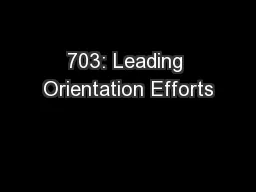

Agenda Introductions The importance of staff orientation Orientation strategies grounded in best practice Assessming the strengths and gaps Action planning Summary and workshop c losure ID: 749115
Download Presentation The PPT/PDF document "703: Leading Orientation Efforts" is the property of its rightful owner. Permission is granted to download and print the materials on this web site for personal, non-commercial use only, and to display it on your personal computer provided you do not modify the materials and that you retain all copyright notices contained in the materials. By downloading content from our website, you accept the terms of this agreement.
Slide1
703: Leading Orientation EffortsSlide2
Agenda
Introductions
The importance of staff orientation Orientation strategies grounded in best practiceAssessming the strengths and gaps Action planningSummary and workshop closure
2Slide3
Learning Objectives
Identify the relationship between staff orientation and other organizational factors
Identify components of an effective orientation programAssess the strengths and gaps in agency capacity to enhance orientation practiceIdentify quick wins to support the orientation of new workers3Slide4
According to Research…
Children
with one caseworker had a 74.5% chance of permanency compared to 17.5% for children with two workers, and 5.3% for children with three workers. (Flower et al., 2005).4Slide5
Caseworker Turnover
Many workers admit to not having been provided the resources and opportunities to develop the needed
skills to perform successfully in child welfare. They attribute their own lack of competence and that of their co-workers and supervisors to negatively affecting job satisfaction. This has been identified as a major cause of casework turnover.
(Hewitt, Larson, &
Lakin
, 2000; Larson,
Lakin
, &
Bruininks
, 1998).
5Slide6
According to Research…
Reducing
stress and providing realistic information about job stresses to new employees after hire can reduce turnover. (Larson, S., Hewitt, A., 2012)
6Slide7
Onboarding
or
Orientation?7Slide8
Two Main Functions of an Orientation Process
To introduce new employees to the culture of the organization and provide opportunities to acculturate.
To foster understanding of how a new employee’s job functions connect to the larger agency. 8Slide9
Reflective Thinking Activity
D
iscuss the questions on page 7 of the Participant Guide.Identify at least one main reason you would be interested in enhancing your orientation program?Document this reason on page 8 of the Participant Guide. 9Slide10
Why Take the Time?
What is the
main reason you would be interested in enhancing your orientation program?10Slide11
County Examples
Which aspects
of a model orientation program speak to the needs of your agency?11Slide12
Comparing and
Prioritizing Activity
Answer the questions on page 14 of the Participant Guide:Compare and contrast your list on page 13 of the Participant Guide. Identify three ideas that as a group, you think will have the most impact if implemented. Identity what impact would they have.
Of
the
three
pick one that the group agrees will
have the most impact on the
success of the
orientation program/retention
of
staff.
(For report-out)
12Slide13
Strengths, Gaps, and
Remedies Activity Instructions
Refer to Participant Guide pages 16-17, discuss, and identify the following in small groups:What are the strengths that will help your agency achieve the main outcome you identified? (report-out top 3)What are the gaps/barriers that keep you from reaching your outcome? (report-out top 3)What are the reasons for the gaps
identified/remedies?
(report-out top 3)
Which remedies are most easily addressed?
Identify
three main themes or areas for improvement.
13Slide14
Quick Wins/Next Steps Activity
Identify
at least three “quick wins” you can do immediately to support your agency’s identified orientation effort. 14Slide15
You Must Have Questions!
15Slide16
Learning Objectives
Identify the relationship between staff orientation and other organizational factors
Identify components of an effective orientation programAssess the strengths and gaps in agency capacity to enhance orientation practiceIdentify quick wins to support the orientation of new workers16